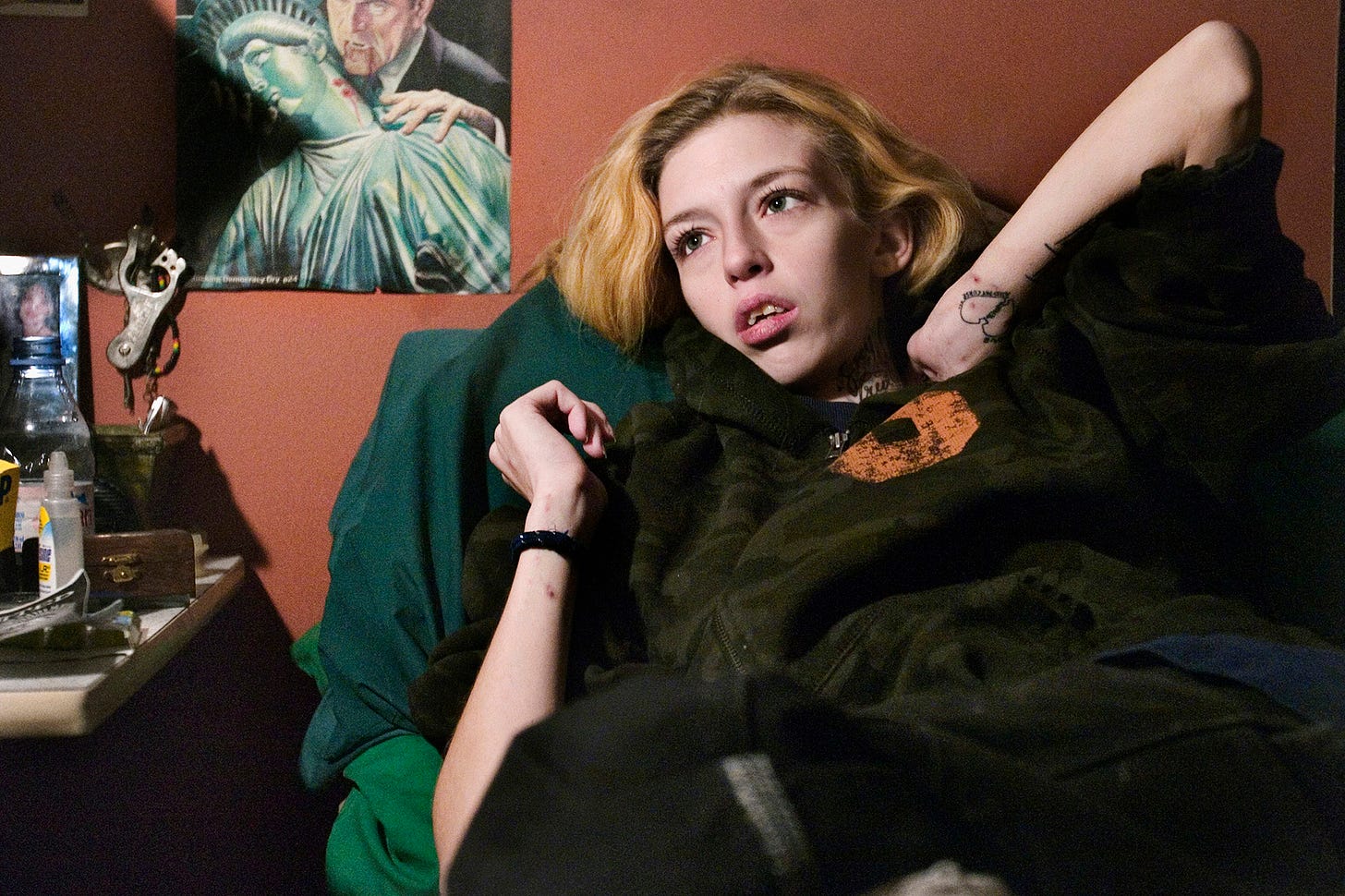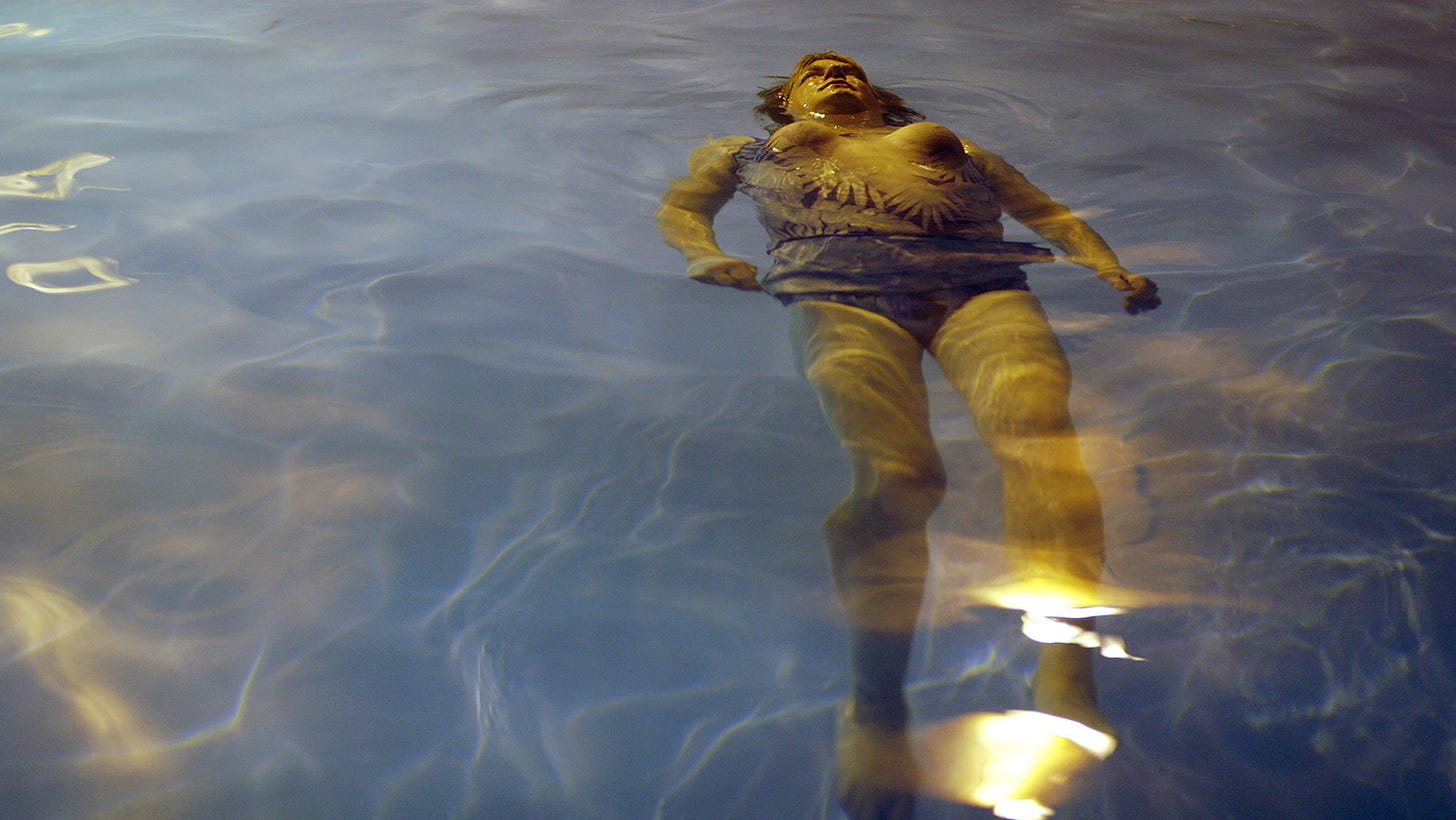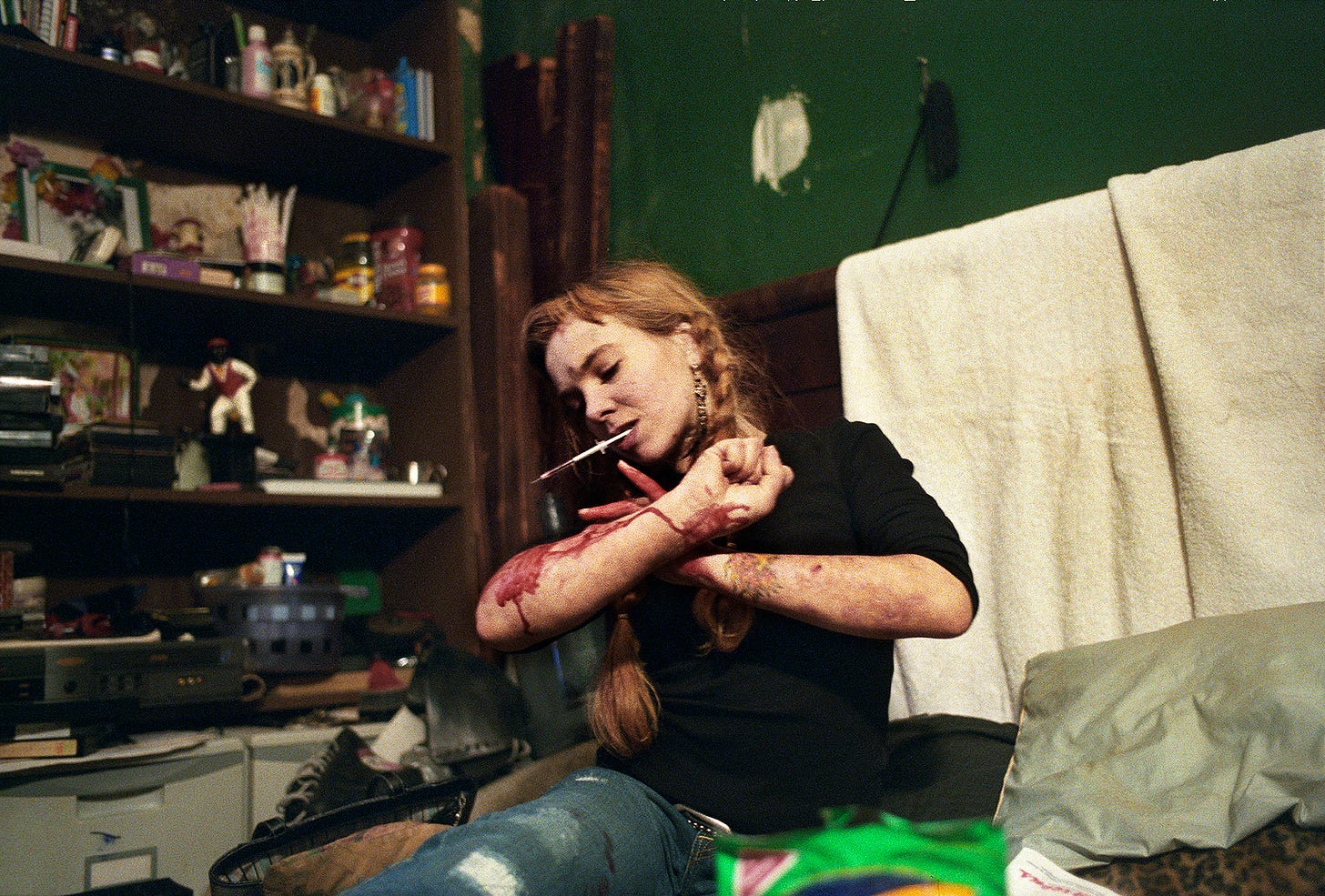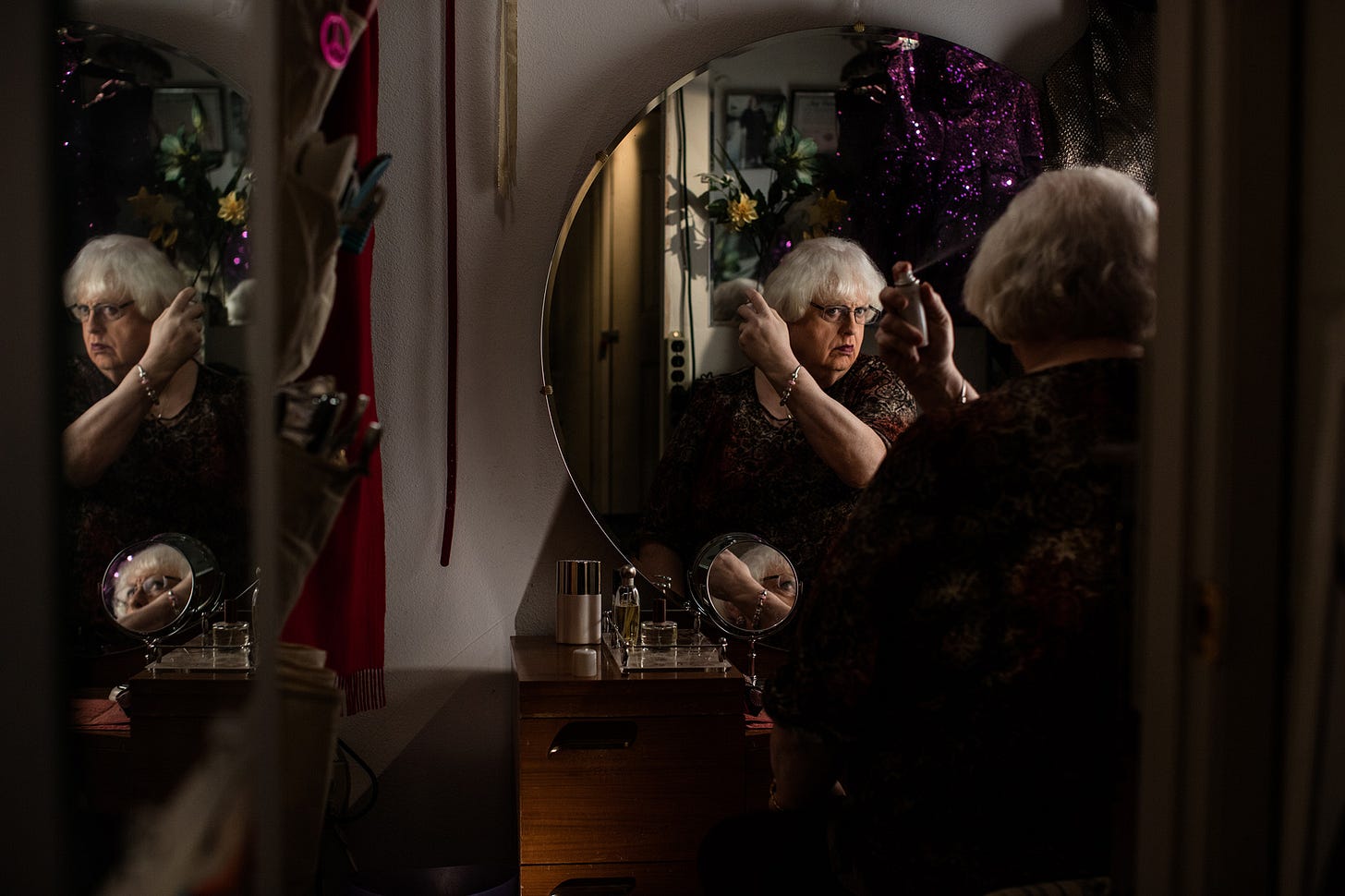Jessica Dimmock on Transitioning from Documentary Photography to Film
“I believe photographers already know how to be filmmakers, they just don't know that they know”
Jessica Dimmock started her career documenting a group of young heroin addicts squatting in an apartment in a wealthy neighborhood in New York City. This body of work was published as a book, The Ninth Floor, in 2007. She then began working as a filmmaker, co-directing The Pearl, about transgender women living in the Pacific Northwest, and the Netflix docuseries Flint Town, following members of the Flint, Michigan police department. Her latest work is an (upcoming) experimental series with Hulu merging narrative and documentary storytelling techniques.
When I was starting out as a photographer, Jessica was already established in the field—a mentor embarrassingly introduced me as her biggest fan. It was true. Her work reminded me of Eugene Richards: intimate, searingly gritty, and empathetic. Over the years, Jessica and I have become close friends and her trajectory from stills to motion has been fascinating to watch. I thought this switch was worth chatting to her about.

Adam Ferguson: You started as a primary school teacher in Brooklyn. Then you studied photography at the International Center for Photography (ICP) while you made your book, The Ninth Floor. Can you tell me a bit about who you studied with, how you ended up at ICP, and how you went from a primary school to a heroin squat?
Jessica Dimmock: I had always taken photographs as a young teen, and then through high school and college. It was the thing that made everything else disappear. I would set up a darkroom in my bathroom, and on weekends in high school, I would spend the entire weekend in there while friends were out at parties.
But I always assumed photography was a thing other people did as a living, so I pursued teaching after college. I never wanted to be a teacher. It was just an opportunity that came up and it seemed interesting. Then I met someone who's now a dear friend of mine. I encountered Romeo at a coffee shop; he was an artist who was a little bit older than me, and he had gone to the Rhode Island School of Design. I remember going up and asking him if I could buy him a coffee and ask him questions. He was like, "You should quit teaching and go to art school." And that's what I did.
Adam: Can you tell me where you were teaching in Brooklyn and what that looked like?
Jessica: I taught at a low-functioning elementary school for two years. My third day of teaching was September 11, and I had 33 third graders by myself—I had no idea what I was doing and certainly no idea how to get through it. After that, I taught high school history for a year in another public school. (It's the subject of the podcast Nice White Parents from the New York Times.) Then I quit and never and never looked back.
Adam: Then you went to ICP, and you made your first project, The Ninth Floor, while you were studying. How did you end up photographing addicts who were squatting in an expensive part of manhattan?

Jessica: It came from an ICP assignment to photograph a stranger. I was on the street with my camera when I was approached by a guy. "Are you a photographer?” he said. “Do you want to photograph me?" He made it clear he was a cocaine dealer. "If you want to follow me around, you can."
I had two bottles of wine with me because I was on my way to a dinner party. I put them down on the street and was like, I guess this is wine for someone else now. He took me to a bunch of places. I had no idea how a digital camera worked at the time; I was using one with an automatic flash and the flash was popping off as he was leaning into the camera, showing me all this cocaine. It was all very crazy.
I came back to my ICP class with my teacher, Andrew Lichtenstein, who is just one of my favorite people. I showed him this stuff and he was like, "oh, you are following this."
The third time I photographed the cocaine dealer, he brought me to the apartment where The Ninth Floor takes place. Then he got arrested. I was trying to call him, but his phone was off. I was so new at this. I didn't write down locations or get the numbers of people. Then he went to jail, and I was like, fuck. I know there's this incredible story out there, but I don't remember which building it is in.
I lingered around Union Square for weeks at a time. Finally, I saw one of the people I had met, and he brought me back to the building. I printed out pictures for the people living there, and they liked them; they started putting the photographs on bulletin boards. They said I could come and photograph anytime I wanted. So I just started showing up.
Adam: I always find it fascinating how these people pop up and lead you to other worlds.
Jessica: It's the most beautiful thing. But it can also be hard because that's how I work now—something has to bump into me.
Adam: When I look at work I enjoy, it's often work that comes from that process. I think that's the hard thing about working on assignment—you're thrust into something on a quick timeline. It's very hard to get a process going where it unfolds naturally, where you make intimate and meaningful photographs.
Jessica: Yeah, totally.
Adam: So you worked on that project and then you published The Ninth Floor. I remember seeing that book when I was coming up as a photographer and I was blown away. I knew I needed to meet you. It was, and is still, an incredibly well-regarded book. But after this, you decided to start working in motion. I guess that's the big question I've got for you. Why the shift?
Jessica: There's a little bit of transition that happens in between. I made The Ninth Floor, and then Moby, the musician, contacted me. He had seen the book because he and Romeo, the friend from the coffee shop, were friends. Moby contacted me, "I really love this body of work,” he said. “I was wondering if you would photograph me for a while. I have a new album coming up." I went over to his house and photographed him. Moby was a vegan who had quit drinking and had stopped abusing other drugs. So there wasn't a lot of edge there, but I made some work for his album.
Then he contacted me again and said, "I've got a title track on this new album. Would you make a music video for me?" I had never done anything with video ever, but you don't say no to that. You say yes, and think "okay, now I have to figure out how to make a music video."
Moby was like, "Could you not make a standard music video? Would you make some video art for me?" I went back to Jessie from The Ninth Floor and filmed her with the idea I would base a character on her. Maybe there's such a thing as a documentary music video. Then we cast an actress to play her, but when I looked at the shoots side by side, I thought, why would I have someone pretend when I could just use the real thing? I asked Jessie if it was okay with her, and it was.
So basically, the move was: The Ninth Floor, working for Moby, Moby asking me to make a music video, making a music video, and then being like, whoa, this is very fun and cool.
Adam: What is it about that process that started to feel more appealing than working with stills?
Jessica: There always was a cinematic thing I was trying to do in my photography. My best work felt like film stills. It also opened my mind to stories that weren't as interesting as still photography projects.
Adam: I can totally relate to that. That's one of the limitations of being a photographer I think. So many stories don't necessarily translate to good still photographs. What are the parallels and differences between making still photos and making films?
Jessica: The parallels are big. At its core, both photographers and filmmakers are interested in bringing an audience into another world. Both are rooted in observation and perception, both gain from the inclusion of metaphor. They are mediums that, at their best, should strive to be more than literal. They should transport and transform. Photographers are always about the limitations of stills, the format makes that necessary. That training also lays a very good foundation for thinking about cinema.
For The Pearl, I'd stumbled upon a hidden and secretive conference for senior transgender women in the Pacific Northwest. Nearly everyone from that project had extremely well-formed male identities. They weren’t construction workers or members of the military, but they had a hidden secret and one week a year got to live as their authentic selves as women. Their wives didn't know that they were there; it was all very secretive.
I saw the potential in doing the project without a big crew or a lot of other people. Just because I was there with a camera didn't mean that I should be up in people's faces. The camera didn't give me permission—I learned by doing The Ninth Floor, by doing assignments, by flying into a place for two days, and being like, "tell me about your most horrible pain."
I knew right away how to develop a relationship with these trans women. I understand there is validation in speaking about something you haven't talked about by communicating a realness about yourself. I was going to develop this relationship respectfully.
Adam: And what about going from seeing from stills to seeing in motion? How did that evolve?
Jessica: It evolved from allowing people to sit in silence. Just because I was shooting video didn’t mean people had to talk to me all the time. Sometimes there’s an uncomfortable way someone tenses up when someone else comes into the room. Other times there’s a sad look in someone’s eyes when they think about something that’s clearly on their mind. You don’t need to hear them say the words. You can see it.
Photography relies on that so much. It is about the expression in a subject’s eyes, it’s about body language because we don’t have the tool of spoken language. Coming from photography means I’m aware that silence is just as powerful a tool as speech.
There’s a lot of emotion that happens in the absence of language. There’s a moment in The Pearl where one of our characters, who has just been out and dressed as her female self for the evening, has just changed in her car. They are back to being a man and are returning home to the wife. We’re filming as he goes up to the doorway and opens the door. He’s wearing a mic, and as he opens the door, you hear him sigh in resignation. There’s a lot of emotion in that. We can understand a lot about how people are feeling by the subtle sounds they make.
Adam: That’s so interesting. A still photograph is very condensed; it’s so condensed that it almost becomes a fiction of an actual event. But I guess in filmmaking you have this multi-dimensional expanded narrative, which is much closer to someone’s story and what really happened.
Jessica: I always think of photographs as very, very tight. They have to be because they are so limited in scope. To be good at taking photographs is to use these limitations in your favor.
Film is expansive. You need to stretch everything out. You need to allow for a moment to happen, not catch it right away. That’s one of the things that’s hard when you’re shooting video after shooting stills. You start picking up your camera every time there’s a moment you want to see. You’ve got to allow for so much more to happen. With film, the moment isn’t the thing—it’s what leads up to the moment and gets you out of the moment.
Adam: You remind me of when I was shooting motion alongside you; I was jumping around everywhere trying to make stills while my camera was rolling, and you told me to stay still and let it unfold.
Can we do an exercise with one of your still photos? From The Ninth Floor, the photo of Natasha who is struggling to find a vein to inject heroin in the squat in New York. If you approached that moment as a cinematographer, not a still photographer, what would you have done?
Jessica: What struck me about that moment was that there was something grotesque going on. Natasha was digging for her vein, but she was also in her own world. I didn’t want to depict what she was doing as ugly. I wanted to try to find a moment when her body looked graceful…
Adam: And it’s beautiful.
Jessica: This blood is so loud; it’s so violent. I wanted to find stillness. Today I might shoot this scene with a phantom camera, which shoots super, super, super slow motion—up to 10,000 frames-per-second, as opposed to 24 frames-per-second. I would maybe do a similar camera positioning, similar layout, but allow her to be seen in movement as still grateful and beautiful. Not the digging, digging, digging that was going on.
Super slow motion is haunting and tends to be almost dissociative because our eye doesn’t work this way. There’s also a little bit of 3D quality to it, where it just gets very hypnotic. So that’s probably how I would approach it. The sound would also be somewhat quiet.
Adam: Would you move around the room and choose different angles, or would you have a second camera?
Jessica: I don’t think I would, but I would need to be there again. So much video work is about getting coverage. In photography, you can find one angle that’s the right angle and I carry this into my motion work.
Adam: I’ve been devouring Team Deakins podcasts and one of the things that comes up with the directors and cinematographers that I’m drawn to and excited to listen to, is that they tend to shoot one camera and not multiple cameras. They shy away from the coverage in different angles; they commit to one frame, as you have described.
Jessica: More and more, I’m into doing fewer things and doing them well. It depends, though, every situation requires different things.
Adam: You were a few years ahead in your career when we met, but we had similar trajectories and grew up in the same photo agency. I feel like when we started as photographers, you developed a visual language. You had one trick or one style, and you replicated that over and over.
When I look at an older generation, all the greats who tended to do that had a very distinct language. But I find myself at this point in my career, approaching every subject differently. With my Australia work, I’m choosing to shoot in harsh light a lot of the time and work with analog because I think it's the right tone for the story. And then for other projects I use very baroque lighting and digital equipment, and it looks completely different. I’m approaching everything with a specific treatment. What are your thoughts on that? How do you think visual storytelling for photographers has changed?
Jessica: When I first started doing film stuff, I called myself a DP—director of photography—because that was the role I thought made sense. I’m more in the driver’s seat when doing film because it requires many decisions: the way you record sound, the way you light. I’m not a videographer or cinematographer, I’m a director. I’m making conscious choices all the time. I think that informs the still photography work that I do now.
Adam: Where do you look for references? Do you still look at stills for inspiration for your films? Or do you look at other films? I know a lot of filmmakers look at still photography when they’re deciding on the visual language and tone of a production or the type of cinematography that suits a story. Where do you look for inspiration for your filmmaking?
Jessica: I’ve always looked at films more than I’ve looked at photography. Even when I was photographing more, the references were more from the cinema world. And I think that continues to be the bigger reference point for me because it’s about the alchemy of how the ingredients fit together—the decisions people are making and the rules they’re breaking.
Adam: Any films that you want to name?
Jessica: Last night I watched a film from 2018 that I thought was great called The Raft. It’s about this experiment from the 1970s where a scientist put 11 men and women on a raft, and they sailed across the Atlantic for 100 days to study violence and what makes people violent. They filmed some of it at the time, but they also remade the raft on a soundstage and brought the people still alive back into that space.
It was a fascinating film, but it was also expansive. It made me think about how to play with the past and present in a way photography can’t by using real people as re-enactors.
Adam: What kind of films inspired you when you were starting out?
Jessica: I’ve always loved documentaries. Documentaries have been beautifully shot for a long time, but many documentaries have also been poorly shot. They haven't been pleasurable to watch. It's just that you had a good story, and someone threw a video camera on their shoulder and away you go. Being a photographer comes with the benefit of knowing how to tell a story and knowing how to tell it beautifully.
But I think the one in more recent years that cracks it all open was Joshua Oppenheimer’s The Act of Killing. And I am not alone in thinking that. Werner Hertzog and Errol Morris both executive produced it, and in interviews with them, they were just like, “This director figured out how to crack a thing that we have not been able to figure out how to crack yet.” Oppenheimer was using real people as actors in the movies of their own lives. That was just so transformative.
Adam: It blew my mind as well. You reminded me of something you said when we chatted previously. You made a statement along the lines of, every photographer has a latent filmmaker in them. Can you tell me a bit about that?
Jessica: I believe photographers already know how to be filmmakers, they just don't know that they know. A photographer knows how to come into a situation. No one else is there. No one else is telling them what to do, and they make all these choices. They decide. That’s the directing part. There are many mistakes to be made and a learning curve when attempting filmmaking, but those are not insurmountable. I think the brains are the same. It’s just a matter of getting out of habits that work for one thing that doesn’t work for another.
Adam: It raises an interesting question about documentary photography because there is sometimes a false belief that documentary photography is objective. We make decisions based on so many different things, there is always an inherent bias to documentary photography. Using that bias is the same thing you’re explaining you do as a filmmaker.
Jessica: There’s a manipulation that often is uncomfortable to talk about in the culture of photojournalism. All filmmakers make changes. I would say certainly 90% of filmmakers mess with interviews. They substitute words or play things in slightly different orders in ways that I think my documentary photography colleagues would be like, “What?”
Adam: But that’s a way to construct a story.
Jessica: There are dishonest ways of doing it, which are absolutely not okay, and then there are honest ways of doing it, where it’s like, she fumbled that word, she misspoke. And sometimes you know things about the story that you can say like, “Okay, if I put this here, my audience will understand it better.” No, we do it in photography, too. We’re just not as explicit about it.
Adam: Most of your work gravitates towards very dark subject matter.
Jessica: Yes.
Adam: Why do you think that is? Past-life trauma? Current life trauma?
Jessica: I think I’ve always been able to spot pain easily. It’s something my radar is constantly scanning the environment for. I think I gravitate towards it because I want there to be compassion for a set of circumstances that people are in.
My work is dark, but it doesn’t make villains into heroes. It just tries to make an audience think: What would it feel like to be this person? What would it feel like to have these sets of circumstances around you? And is there a way you can see how this person is still beautiful, despite these circumstances?
You can follow me on Instagram here.
If you have questions about photography you’d like to have me answer, get in touch at mail@adamfergusonstudio.com





I learned so much from just this short conversation, very insightful! Trying to balance photography and filming at the moment, not always easy. Great to hear you talk about it, thanks!